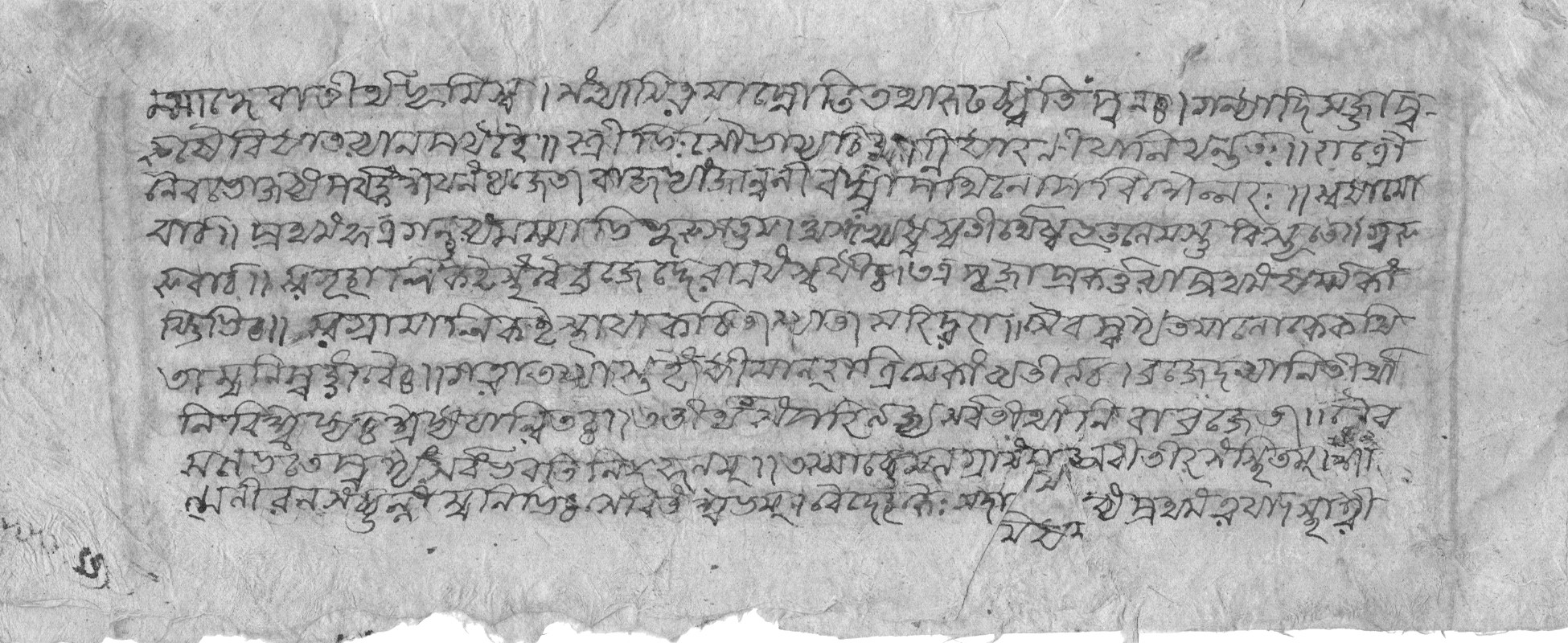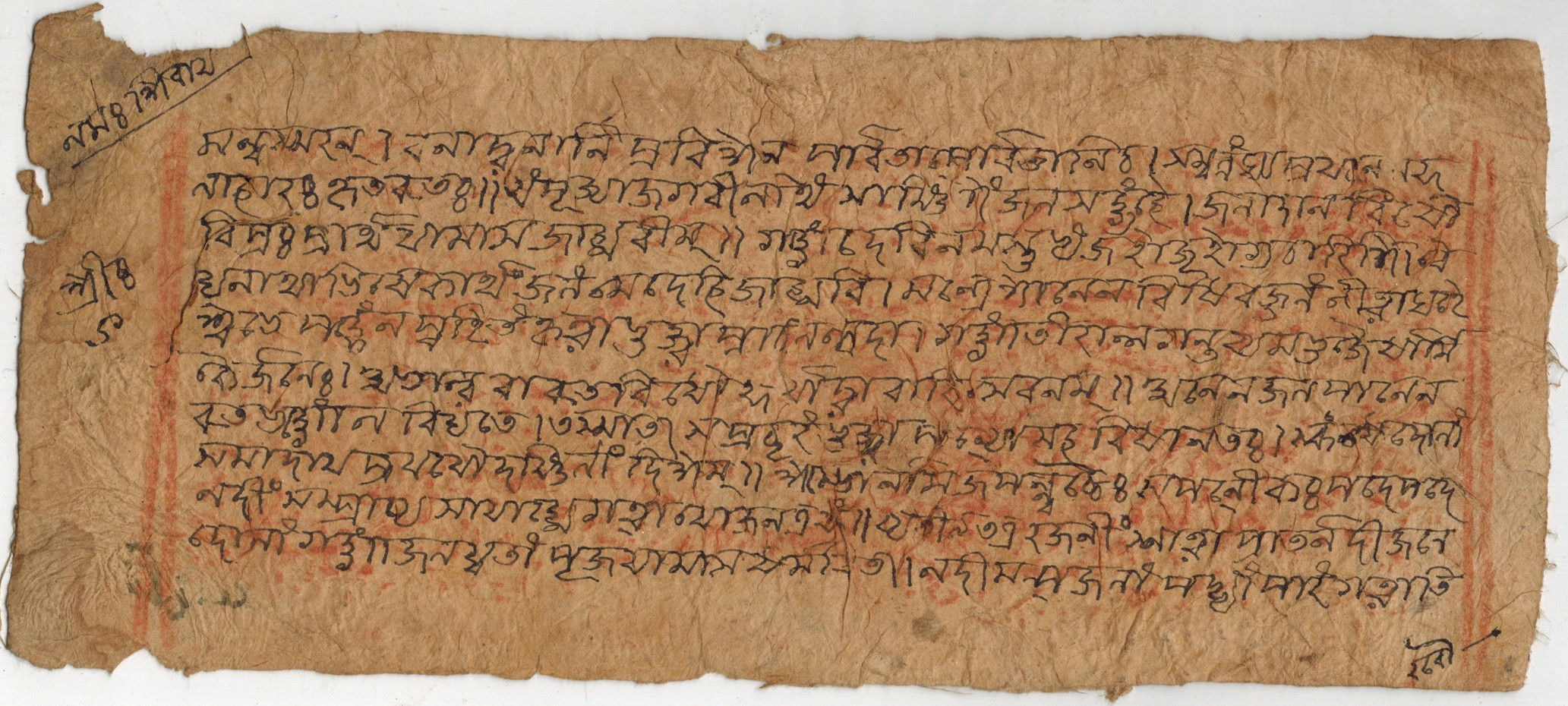I have a manuscript in my possession dealing with the history of Mithila. I have found it in scattered position with some another old papers and a manuscript in Devanagari, beside the road at Ladora village near Kalyanpur block headquarters in Samastipur district in 2013 while I was on the way to Ajit Kumar Mehta Sanskrit Shikshan Samsthan, a Sanskrit college affiliated to Rastriya Sanskrit Sansthan, Delhi.










The manuscript measuring 10”×8.5” on handmade paper has 6 folia written in fair Mithilakshar. The manuscript starts with the 1st chapter and breaks after 17th shloka of the second chapter. In the colophon of the first chapter the scriber indicates his place Teghara, his name Jivanath and the date of scribe 1310 saal i.e. 1901 A.D. CE. The scriber narrates that he has written this manuscript on the basis of an old and tattered manuscript so he has also corrected somewhere the broken text by his own knowledge. The holder pen and Company made ink is used for the writing of this manuscript.
The first chapter of this text bears 79 slokas and the second only 17. The colophon indicates the name: Teerthyatra-vidhana in the Rudrayamala-saaroddhara (i.e. a manual of the pilgrimage in the abstract of the Rudrayamala)
The story of this text is as follows:
There was a merchant named Sudhama in Pandava village. When he became aged he wanted to go for pilgrimage and went to his Guru for getting directions and manuals. His Guru, the preacher, told him the story of the pilgrimage of an ancient king of Mithila
According to this story, when the King of Videha started his pilgrimage, he went to the bank of Ganga at first where many sages were engaged in austerity. The King being attracted, established four temple in this forest full of Bombax (Semala) tree. Thereafter the place was called Chaturmath teerth (चतुर्मठतीर्थ). The king started his pilgrimage from this bank by baoat and went to Varanasi, Prayaga and again on returning he went to Ayodhya through Sarayu river via Vamana teerth at the confluence of Ganga and Sarayu. He offered golden small bells at Rama-janmabhumi and again he came back to the Chaturmath Teerth where an even took place. Here the first chapter ends.
In the second chapter the pilgrimage to Vaidyanath Dhama is narrated.
When he returned to that place he found that a great violence was made by Turkas in their territory. He was tired so he became very sad. Then sages reliance him that ‘the shalmali teerth is so holy that Turkas (incursionist from Turkey) can not enter here. In the past time after the churning of ocean the demons had been confused in this forest by Mohini (Lord Vishnu). This story has been narrated by Lord Shiva to Goddess Parvati previously.’
Here the first chapter ends.
By the scrutiny of this story we can find that the said village Pandava was situated in modern Samastipur District on the north side of Ganga. Now this village is called as Pand (पाँड़), an important archaeological site. The Chaturmatha teerth is identical with Chamtha Ghat near Vidyapati Nagar and the modern name has been derived from the word Chaturmatha (i.e. four temples). The village full of Semala tree was named Shalmli Grama.
While fixing the date of this text we have to remember that it is said to be a portion of the extracts of the original Rudrayamala. Actually it was written in later days, as an independent text, but, after sometime, by an innocent scriber, it was mentioned as the portion of the Rudrayamala. Here we find the invasion of Turkas (the general word for Yavana) which occurred from 12th century to 15th century. But the Rudrayamala was written long before this period.
The time of this scripture may be defined on the two basis. Here we find the mantion of Vaidyanath in a cave. It may be a small temple but not a big one which is lying now. We have an epigraphic evidence of the date of the construction of present temple by Purana Malla of Giddhaur state in 1596 A.D. thus this portion was written sometimes before this construction. The Second evidence is that here a living temple on Rama’s birthplace at Ayodhya is mentioned in which the King had offered golden small bells. The present historical finding said that Babur(1525-29 A.D.) had destroyed the temple and made a mosque thereon. (The second evidence is weak because Kishore Kunal in his book ‘Ayodhya Revisited’ has proved that this temple was destroyed by Aurangzeb not by Babur.)
The third evidence is related with the history of Chaumath Ghat. This Ghat is related with the story of the death of famous Maithila poet Vidyapati. It is said to be that the poet wanted to go to the Ganga-snana in his old age. His target was the very Ganga-ghat i.e. Chaturmath Teerth. We find the mention of this Ghat in another portion of the Rudrayamala named Rudrayamalokta-Amritikarana Prayoga रुद्रयामलोक्त-अमृतीकरण प्रयोग)). It is published from Darbhanga in 2011 edited by two scholars from Kameshvara Singh Darbhanga Sanskrit University, Dr. Vidyeshvar Jha and Dr. Shravan Kumar Chaudhari. In this scripture the Chaturmath Teerth is stated as a denser forest as Shalmali Vana but the present portion indicates the development of that teerth and establishment the priests on that place. Here this is developed in a village named Shalmali-grama.
Thus we can fix the date of this portion between 14th to 16th century.
Here we may suggest that when Vidyapati wrote the Bhu-parikramanam, there after many small and local texts had been written with geographical accuracy in Mithila region and after sometime these were advertised as the portion of the famous text Rudrayamala.
We have also found another portion as Mithila Teerthvidhi, which mentions many religious places in Mithila. This text also may be placed in 14th to 16th century.